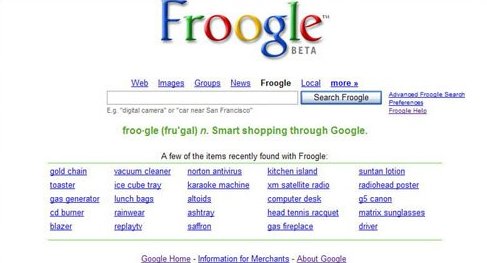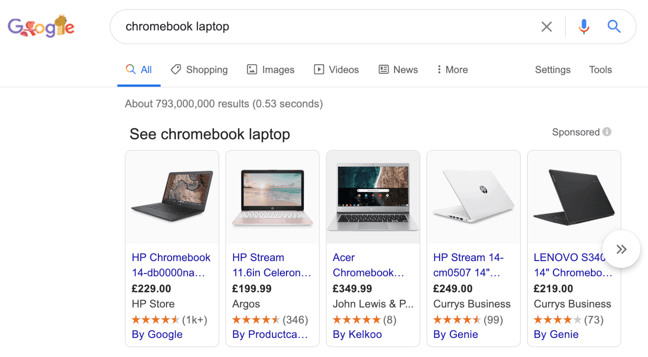Updated on October 3, 2024 | 5 minute read | Rebecca Cooper
Home > Resources > Google Shopping is free? Google Shopping Update
Google announced “it's now free to sell on Google” in a recent blog article announcing that they are going back to the “Froogle” days and opening Shopping tab results up to organic listings, perfectly timed as many retail shops have had to close their doors due to coronavirus lockdown restrictions.
Why has Google made the decision to do this?
Google’s long term goal is to provide the best solution for customers actively searching for products. To understand why making product listing free will help them reach this goal, we have to take a trip back in time…

Google Shopping (Froogle) was free for all merchants and not a PPC channel back in 2002. The benefit was, in theory, all products could become searchable in a single place. This helps customers, as it makes it easier to source hard to find products, models, styles, collectables etc. and allows the customer to use price comparison to aid them in their buyer journey.
The reality was, it was still technically difficult for low tech retailers to use the platform, as it required the creation of a feed submitted to the merchant centre. This was challenging for many retailers, especially in 2002. The quality of results was also very low and therefore provided a poor quality shopping experience, as retailers offered out of stock items (due to infrequent data feed refreshes) and some incorrect results to try and win additional free traffic.
Got a question about Smart Shopping? Check our FAQ answers here.
Now just to be clear, Google hasn’t made all of Google Shopping completely free. The Google Shopping tab will contain free, organic product listings, but the Google Shopping carousel that accounts for 95% of clicks, as well as some paid ads in the primary positions of the Shopping tab, will still follow the pay-per-click format.
More information on PPC campaigns is available here.

Technology has moved on a lot since the days of “Froogle” and retailers regularly use the platform to reach engaged customers, whether they manage this themselves or with a specialist. Secondly, by providing some free organic listings, Google is encouraging retailers who have never used the platform before to sign up, thus encouraging future “add ons” of using paid ads to increase reach.
This coincidentally times well with the lockdown restrictions set on many countries, temporarily shutting down a lot of retail stores. Although this has been in Google’s plans for a while, they have accelerated the launch to “support struggling retailers”, “with hundreds of millions of shopping searches on Google each day, many retailers have the items people need in stock and ready to ship, but are less discoverable online” – Ready states.
Many have also highlighted that this is Google’s strategy to further compete with Amazon, with Jeff Bezos reporting an added $24 billion to his personal wealth since the outbreak. Google’s aim is to encourage more advertisers to Google Shopping and have them compete for limited availability to continue to increase CPC prices. A focus remains on getting bricks and mortar stores to move online and sell via shopping, tying into Google’s recent acquisition of Pointy and focus on Local Inventory Ads, linking Google Shopping with nearby high street stores product inventory.
The Google Shopping carousel, made up of the paid product listing ads (PLAs), will remain as completely paid ads only and the Shopping tab will have paid ads at the top and bottom of searches, similar to how the main search page is laid out. The free, organic listings will be powered by product data feeds, the same as paid ads, and uploaded to the merchant centre. Sellers need to opt-in to gain access to the free listings.
95% of clicks happen on the carousel (PLAs), which will remain paid, so don’t expect your Google Shopping budget to come down significantly.
This was announced in March 2018 (Google Shopping Actions) and properly launched one year ago in March 2019 in the US & France. Google is just using the hype of Covid-19 for their benefit to promote this feature further.
It’s very likely that organic search results will have a lower Conversion Rate (CR) as the relevance in the product listing relies on the merchant feed quality.
Download our playbook on CR optimisation here.
Consumers will have more choices, as more retailers will be visible on the Shopping tab.
This is good news for many retailers, as there is the benefit of extra organic results, however, the majority of clicks will still come from paid. This move will encourage more retailers to take advantage of Google Shopping, so expect there to be more competition for visibility.
On the other hand, this should encourage more customers to rely on Google Shopping for their product searches, strengthening the capabilities of the channel connecting retailers to consumers. Now is an ideal time to ensure your strategy is optimised, to ensure you are taking full advantage of this new step from Google and remaining ahead of competitors.
If you’re still feeling a little confused about taking advantage of this new offering from Google and how this will impact your current Google Shopping strategy, browse our handy Google Shopping updates and FAQs, or book a free consultation with one of our specialists.

